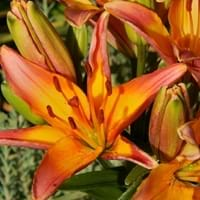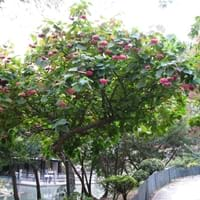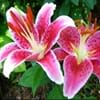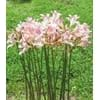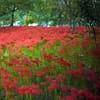Life Span
Perennial
Perennial
Type
Bulb or Corm or Tuber
Shrub
Origin
Hybrid origin
Eastern Africa, Madagascar
Types
Not available
Not Available
Habitat
subtropical regions, Temperate Regions
gardens, Screen Cottage and Informal Garden
USDA Hardiness Zone
4-8
9-15
Sunset Zone
21,22
H1, H2, 22, 23, 24
Habit
Upright/Erect
Oval or Rounded
Flower Color
Gold, Pink
Pink, Hot Pink, Magenta, Rose
Flower Color Modifier
Bicolor
Not Available
Fruit Color
Green, Brown
Not Available
Leaf Color in Spring
Green, Dark Green
Green, Light Green
Leaf Color in Summer
Light Green
Green
Leaf Color in Fall
Several shades of Green
Green
Leaf Color in Winter
Light Green
Green
Leaf Shape
Lanceolate
Cordate
Plant Season
Spring, Summer
Spring, Winter
Sunlight
Full Sun, Partial Sun
Full Sun, Partial Sun
Type of Soil
Clay, Loam, Sand
Loam, Sand
The pH of Soil
Acidic, Neutral
Acidic, Neutral
Soil Drainage
Well drained
Well drained
Bloom Time
Early Summer, Summer
Early Spring, Spring, Winter, Late Winter
Repeat Bloomer
No
Not Available
Tolerances
Drought
Drought
Where to Plant?
Ground, Pot
Ground, Pot
How to Plant?
Bulbs
Semi-hardwood and hardwood cuttings, Stem Cutting
Plant Maintenance
Medium
Medium
Watering Requirements
Average Water Needs
Average Water Needs, Do Not over Water, Requires regular watering
In Summer
Lots of watering
Lots of watering
In Spring
Moderate
Moderate
In Winter
Average Water
Average Water
Soil pH
Acidic, Neutral
Acidic, Neutral
Soil Type
Clay, Loam, Sand
Loam, Sand
Soil Drainage Capacity
Well drained
Well drained
Sun Exposure
Full Sun, Partial Sun
Full Sun, Partial Sun
Pruning
Remove damaged leaves, Remove dead branches, Remove dead leaves
Remove damaged leaves, Remove dead branches, Remove dead leaves
Fertilizers
All-Purpose Liquid Fertilizer
All-Purpose Liquid Fertilizer
Pests and Diseases
Red blotch
Red blotch
Plant Tolerance
Drought
Drought
Flower Petal Number
Single
Not Available
Foliage Texture
Medium
Coarse
Foliage Sheen
Glossy
Not Available
Attracts
Hummingbirds
Butterflies
Allergy
Not Available
Not Available
Aesthetic Uses
Beautification, Bouquets
Cottage Garden, Formal Garden, Showy Purposes
Beauty Benefits
Not Available
Not Available
Environmental Uses
Air purification
Air purification
Medicinal Uses
Not Available
Not Available
Part of Plant Used
Flowers
Flowers
Other Uses
Showy Purposes
Dried heads are used in floristry, Grown for shade
Used As Indoor Plant
No
No
Used As Outdoor Plant
Yes
Yes
Garden Design
Container, Cutflower, Feature Plant, Mixed Border
Hedges, Mixed Border, Screening, Wind Break, Tropical
Botanical Name
LILIUM 'Ladylike'
DOMBEYA wallichii
Common Name
Asiatic Lily, Ladylike Lily
Pinkball, Pink ball tree, Tropical hydrangea
In Hindi
Ladylike lily
Pink Ball Tree
In German
Ladylike lily
Pink Ball Tree
In French
Ladylike lily
Pink Ball Tree
In Spanish
Ladylike lily
Pink Ball Tree
In Greek
Ladylike lily
Pink Ball Tree
In Portuguese
Ladylike lily
Pink Ball Tree
In Polish
Ladylike lily
Dombeja Wallicha
In Latin
Ladylike lily
Pink Ball Tree
Phylum
Not Available
Tracheophyta
Class
Liliopsida
Magnoliopsida
Family
Liliaceae
Sterculiaceae
Clade
Angiosperms, Monocots
Angiosperms, Eudicots, Rosids
Tribe
Not Available
Not Available
Subfamily
Not Available
Dombeyoideae
Number of Species
Not Available
Difference Between Ladylike Lily and Pink Ball Tree
If you are confused whether Ladylike Lily or Pink Ball Tree are same, here are some features about those plants to help you choose better. Many people think that these two plants have the same characteristics, but one can see Ladylike Lily and Pink Ball Tree Information and learn more about it. Fertilizers required for proper growth of Ladylike Lily are All-Purpose Liquid Fertilizer, whereas for Pink Ball Tree fertilizers required are All-Purpose Liquid Fertilizer. Hence, one should know the basic difference between Ladylike Lily and Pink Ball Tree if you are planning to have them in your garden to enhance its beauty.
<
Flowering PlantsImportance of Ladylike Lily and Pink Ball Tree
Want to have the most appropriate plant for your garden? You might want to know the importance of Ladylike Lily and Pink Ball Tree. Basically, these two plants vary in many aspects. Compare Ladylike Lily and Pink Ball Tree as they differ in many characteristics such as their life, care, benefits, facts, etc. Every gardener must at least have the slightest clue about the plants he wants to plant in his garden. Compare their benefits, which differ in many ways like facts and uses. The medicinal use of Ladylike Lily is Not Available whereas of Pink Ball Tree is Not Available. Ladylike Lily has beauty benefits as follows: Not Available while Pink Ball Tree has beauty benefits as follows: Not Available.
Compare Facts of Ladylike Lily vs Pink Ball Tree
How to choose the best garden plant for your garden depending upon its facts? Here garden plant comparison will help you to solve this query. Compare the facts of Ladylike Lily vs Pink Ball Tree and know which one to choose. As garden plants have benefits and other uses, allergy is also a major drawback of plants for some people. Allergic reactions of Ladylike Lily are Not Available whereas of Pink Ball Tree have Not Available respectively. Having a fruit bearing plant in your garden can be a plus point of your garden. Ladylike Lily has no showy fruits and Pink Ball Tree has showy fruits. Also Ladylike Lily is not flowering and Pink Ball Tree is not flowering . You can compare Ladylike Lily and Pink Ball Tree facts and facts of other plants too.
